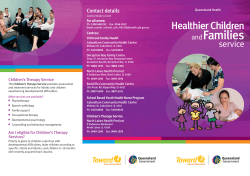
W H D
WHY AND HOW TO DEVELOP A ROAD TRANSPORTATION TECHNOLOGY TRANSFER CENTER? Written by Office of International Programs Federal Highway Administration U.S. Department of Transportation PIARC . 1 . 03.08.B - 2000 CONTENTS 1. INTRODUCTION ................................................................................................................................3 2. TECHNOLOGY TRANSFER.............................................................................................................4 3. PIARC AND TECHNOLOGY TRANSFER .....................................................................................5 4. WHY A TECHNOLOGY TRANSFER CENTER? ..........................................................................6 5. WHAT IS A TECHNOLOGY TRANSFER CENTER?...................................................................7 6. BLUEPRINT FOR SUCCESSFUL TECHNOLOGY TRANSFER CENTERS............................8 6.1 THE BASIC ELEMENTS OF SUCCESS ....................................................................................................8 6.2 BUILDING THE FOUNDATION .............................................................................................................9 6.2.1 Identify user needs. ..............................................................................................................9 6.2.2 Evaluate transportation environment and identify potential successful partners/stakeholders. .........................................................................................................9 6.2.3 Describe local conditions that affect the types of technology and levels of technical expertise that can be transferred .......................................................................................10 6.3 6.4 6.5 6.6 SPECIFY PROGRAMME ACTIVITIES..................................................................................................10 ORGANIZE THE CENTER ..................................................................................................................11 PERSONNEL AND LOGISTICAL REQUIREMENTS ................................................................................12 MEASURE PERFORMANCE AND SUCCESS ........................................................................................13 7. CONCLUSIONS.................................................................................................................................14 8. TECHNOLOGY TRANSFER CENTERS AND NETWORKS REFERENCES.........................15 9. BIBLIOGRAPHY AND INTERNET RESOURCES......................................................................21 BIBLIOGRAPHY ......................................................................................................................................21 SELECTION OF INTERNET ADDRESSES....................................................................................................21 PIARC . 2 . 03.08.B - 2000 1. INTRODUCTION Down through history, economic development and social advancement have inevitably involved transportation of one form or another. Whether it is wagoons carrying farm products on roads to market, rivers and canals facilitating the economical movement of industrial products, or streets easing the passage of village and urban dwellers, similar principles of engineering and transport design have been in use all over the world. As road practitioners have faced and overcome obstacles and challenges in road building and road operations, there has been a recognition that colleagues in the next country or half-way around the world have developed solutions that may have application beyond the original location. As the travel demands of modern society have increased exponentially, there also has been a recognition that haphazard and informal sharing of experiences may no longer be the best approach to improve roads and road transportation. As budgets continue to be inadequate for the task, it becomes incumbent upon road officials and engineers to gain from the developments of colleagues around the world, rather than “re-inventing the wheel" or making the same mistakes that others have made over and over again. PIARC . 3 . 03.08.B - 2000 2. TECHNOLOGY TRANSFER This process of openly gaining and freely sharing experiences, solutions, technologies, and innovations has come to be understood as “technology transfer”. Technology transfer can occur in many ways and different forums. At its simplest form, technology transfer happens when someone reads about a “new” technique in a report or a technical magazine from another place. Technology transfer happens when a university professor in one country learns about and teaches an innovative design method from another country. Technology transfer also can occur when a new product or material is included in a road project by a contractor or consultant from another continent, or another industry. Regardless of the form, ultimately technology transfer is aimed at using the benefits of someone else’s successful research, development or experience to benefit roads locally – often at a fraction of the original development cost. Technology transfer in the transportation sector, as in any field, can be a catalyst for long term change. Regular meetings of professional societies and trade associations historically have been fertile ground for technology transfer and technical advancement. Where such professional societies or associations are not active, or where there is a need to energize the process, Transportation Technology Transfer Centers have emerged as effective agents in such processes for continuous improvement. Successful centers have been operating in North America and Latin America for the past decade or two. The potential for expanding this success around the world is already underway in Africa and Eastern Europe. The membership of the World Road Association (PIARC) has recognized the value of Technology Transfer Centers, and the Association has introduced a programme to encourage the development of new centers. PIARC . 4 . 03.08.B - 2000 3. PIARC AND TECHNOLOGY TRANSFER The World Road Association’s (PIARC) commitment to technology transfer is the crux of its philosophy and mission from the very beginning, nearly 100 years ago. That commitment has evolved, with the Association, from information sharing between developed industrialized countries to include developing nations and countries in transition. At the 1987 World Road Congress in Brussels, PIARC passed a resolution formally affirming the commitment to technology transfer. Over the years that commitment has led to more cooperation, programmes and information dedicated to achieve that goal. The 1995 and 1999 World Congresses in Montreal and Kuala Lumpur reaffirmed those goals in the PIARC Strategic Plan. During the same time period, the idea of Technology Transfer Centers and regional networks around the world grew into a proven and effective mechanism for information and resource sharing. In 1999, PIARC Council passed a resolution that includes initiatives to foster the establishment of Technology Transfer Centers. This commitment demonstrates the Association belief that these centers can play a constructive role in facilitating technology transfer. As part of this effort, this document was developed to: • promote the concept and benefits of Technology Transfer Centers and networks, and encourage the development of new centers, • provide access to resources with expertise to facilitate the process, and shorten the planning and learning curve of new centers. This document serves as a brief introduction to Technology Transfer Centers and includes contact information for selected centers, and references to in-depth written and electronic resources that can be consulted. It is to be expected that a Technology Transfer Center will develop and mature over time. As a center begins operations, not all of the elements described in this document may be present. PIARC . 5 . 03.08.B - 2000 4. WHY A TECHNOLOGY TRANSFER CENTER? Road transportation professionals and organizations (public and private) worldwide need information and knowledge that will enable them to advance their processes, incorporate new products into existing programmes, and increase technical know-how that produces positive change and impact on road systems. A huge universe of institutional and technical knowledge exists and continues to be developed that can be tapped to fulfill varying information and resource requirements. Typically, this knowledge has been passively stored in libraries or research institutions. Unless individual practitioners know what to look for and where to search, this knowledge remains unknown to them. Where technical libraries and research institutes exist, they are a natural base from which Technology Transfer Centers may evolve. Technology Transfer Centers can serve as a focal point and an institutionalized catalyst for active dissemination of technical documents and other technology transfer activities. They should be considered as part of a larger process of the ongoing technology transfer process, and not the sole vehicle for it. Their primary objective is to systematically and actively facilitate the acquisition and dissemination of technology, practice and policy knowledge and know-how that is relevant to a local operating road transportation environment. They can be general in handling all road transportation topics, and adapting techniques to local conditions, or they can be specialized if desirable or necessary. The benefits of a Technology Transfer Center are: 1 - learning of beneficial policies, technologies, programmes and developments earlier and more systematically, 2 - reducing or eliminating duplication or redundancy of products and process development by road agencies, thereby conserving resources, 3 - maintaining a continuing process for seeking technology from elsewhere, 4 - having a proven mechanism for evaluating and adapting foreign technology to local needs, 5 - rooting and supporting the change process within the local road community that knows its own needs and circumstances, 6 - improving skills of practitioners that will lead to improved road transportation systems, PIARC . 6 . 03.08.B - 2000 5. WHAT IS A TECHNOLOGY TRANSFER CENTER? A Technology Transfer Center can be many things to many people. It is natural that Technology Transfer Centers themselves change and evolve over time, just like the change process they foster. A center can only come to exist when a community of practitioners or their leaders recognize that needs exist that are not being met, and they make a commitment to addressing such needs. The following descriptors are common for a Technology Transfer Center. 1 - a Technology Transfer Center is a repository for information about technologies and resources - from cutting edge, or appropriate technology, to good practice; 2 - a center can be a local, national, regional and international conduit between developers and users of technology and policy; 3 - a focal point for advancing better practice through a variety of media and activities (e.g., training); 4 - a platform for systematic technology transfer activities that address and meet unique local transportation requirements; 5 - a catalyst for improvements and enhancements of local practices; 6 - CATALYST: one who advocates the use of improved products and methods by practitioners, and convinces key decision-makers to support such use. These roles serve to increase awareness of the technology and practices within local agencies and by individuals responsible for road and infrastructure construction and maintenance. From PIARC unique perspective, in countries where there are PIARC National Committees, a Technology Transfer Center can also serve as the executive agency or secretariat for the National Committee. Where there is no National Committee, the stakeholders of a Technology Transfer Center can be educated about the benefits of PIARC involvement and eventually become the nucleus of a PIARC National Committee. [See the PIARC publication “Why and How Do You Create a PIARC National Committee?”] In the beginning, a Technology Transfer Center needs to be a “technology informer” – identifying, collecting, and making available local resources for practitioners; and then accessing and joining networks of knowledge resources from the region and other parts of the world (the first two types of centers). As a center matures, it will move to become active seekers, translators, adapters, and promoters of beneficial innovations (the last three types of centers). The natural movement is to move from responders to initiators of the change process. PIARC . 7 . 03.08.B - 2000 6. BLUEPRINT FOR SUCCESSFUL TECHNOLOGY TRANSFER CENTERS Effective Technology Transfer Centers and networks of centers operate in the United States (Local Technical Assistance Centers—LTAP), Latin America and the Caribbean (Pan American Institute of Highways—PIH), the Baltic Centers (Finland and its Baltic neighbours Estonia, Lithuania, and Latvia), South Africa, and East Asia. New Technology Transfer Centers are taking shape in Sub-Saharan Africa, Central Europe and Russia. Each Technology Transfer Center acquires and disseminates technology transfer resources for technologies appropriate to local needs and conditions while maintaining ongoing communication and collaboration with those who will apply the technologies. The achievements of these centers are founded on the awareness that productive technology transfer relies as much on understanding the local state-of-the-practice and circumstances, as it does on the array of available state-of-the-art technology from elsewhere. Although organizational structures and methods vary depending on local conditions, effective Technology Transfer Centers generally share some basic operating characteristics that allow them to successfully perform their functions. 6.1 The basic elements of success 1. Provide systematic technology and information transfer that targets local needs and expertise. 2. Integration into an existing transportation-related institution (government ministry, local authority, academic institution, research laboratory, or professional or trade association) that houses the center as part of its ongoing operation. This relationship saves resources and provides the credibility and contacts necessary to launch new initiatives and programmes. 3. Function independently of host institution to maintain objectivity in its activities, and meet the specific needs of its broader range of stakeholders. 4. Have a visionary “champion” for the Technology Transfer Center who can advance its goals and objectives within the local road transportation professional and institutional community. Such a person could be from the leadership of a road administration, active association, respected researcher, academic, or practitioner. 5. Involve public and private (partner/stakeholder) participation to develop and deliver programmes and projects. 6. Coordinate activities and share information and resources with other regional, national, and international transportation-related organizations and associations. PIARC . 8 . 03.08.B - 2000 6.2 Building the foundation Every new and operating Technology Transfer Center needs to take into account a number of factors that underlie the successful development of the institution itself, the process of technology transfer, and the delivery of relevant programmes. The following sections briefly, and generally, raise key issues in question form followed by the most conducive conditions that are instrumental to the development and success of Technology Transfer Centers. Not all issues must be addressed to start a Technology Transfer Center. As the center evolves, the managers must consider the range of issues noted below in order to remain effective. 6.2.1 Identify user needs A. Who is the target audience? They could be specific, or general, and could include engineers, skilled or unskilled labour, community leaders, decision-makers, public or private sector entities, or researchers. B. Does the user recognize the need for technical assistance? The target audience is cognizant of the need for new solutions to existing problems. C. What, specifically, does the user need to know in order to improve current procedures or practices? New technology, techniques, materials, and processes. 6.2.2 Evaluate transportation environment and identify potential successful partners/stakeholders A. What are government policies relating to advancing road construction, maintenance and innovative techniques or materials? The government encourages (or does not) innovative solutions through funding, training and research. B. Are the necessary private sector organizations or transportation associations committed to operating a successful Technology Transfer Center? Trade associations, professional organizations, universities, chambers of commerce, etc. C. Is the relationship between the public and the private transportation sectors a cooperative one, conducive to collaborative work? The two sectors appreciate the resources, knowledge and skills each possess to improve road transportation. Both understand that their combined experience is greater than the sum of the parts. PIARC . 9 . 03.08.B - 2000 D. What type(s) of resources—monetary and physical—are required and available to support these need(s)? Centers require sustainable or committed sources of funding, space, personnel and equipment to operate effectively. E. Is the road agency receptive to innovative or foreign technology application? New solutions are regularly sought and applied when possible. F. What is the role of the private sector and other transportation organizations or academia in regional/national road development practices? These organizations regularly, and often on their own initiative, provide solutions to existing problems through the development or introduction of new technologies. 6.2.3 Describe local conditions that affect the types of technology and levels of technical expertise that can be transferred A. Is there a local individual or organization who is much aware of both technology and local conditions who can adapt promising technologies to local road characteristics? Practicing engineer, economist, trainer, applied researcher. B. What types of appropriate technology are available for adoption or adaptation to meet local user needs? Labour intensive, high-tech, or other appropriate technologies. 6.3 Specify Programme Activities The heart and soul of any Technology Transfer Center are the basic programme activities and special projects that are developed and delivered to its audiences or users. They usually include, but are not limited to: 1. Communication options • • • • • • print media: regular newsletters, research reports, implementation reports, manuals and brochures, and material from other members of the Technology Transfer Center network; face-to-face presentations such as training courses and workshops, demonstrations, networking sessions and circuit rider or road show programmes; electronic media, including computer programmes, electronic bulletin boards, teleconferences, and Internet sites; cooperative agreements or membership in national and international road associations which give access to information, expertise and opportunities for training; peer interaction through staff exchanges or structured professional development programmes; reinforce technology transfer by disseminating information through more than one medium; PIARC . 10 . 03.08.B - 2000 2. Training options • • • • • self-study guides and interactive computer-based training, short courses, in-depth training institute, on-the-job training or demonstrations, videotapes or CD-ROM; 3. Technical assistance options • • • • call-in or hotline services, information network, World Interchange Network (WIN), or other technical resource system, mobile technical assistance team, twinning relationships with other organizations or Technology Transfer Centers that have the necessary expertise and experience. The Local Technical Assistance Project (LTAP) Centers in the United States and the Certified Centers of the Pan American Institute of Highways maintain five basic mandatory activities: 1 - Compile and maintain a mailing list ¾ identification of users and stakeholders 2 - Publish a quarterly newsletter ¾ communication of successes and available resources 3 - Conduct or arrange seminars and training sessions ¾ delivery of the benefits 4 - Provide material and information ¾ delivery of the benefits and marketing of information 5 - Evaluate effectiveness of programme ¾ feedback for continuous improvement. 6.4 Organize the Center Every center requires a certain amount of basic institutional infrastructure and development to become and remain a viable technology transfer agent. 1. Identify an organization that will agree to house the Technology Transfer Center as part of its ongoing operation, however, the center must have its own identity and space within that structure. 2. Establish a working relationship with the national public agency responsible for roads. 3. Draft mission statement that defines purpose and operation of the center. 4. Establish basic funding needs. PIARC . 11 . 03.08.B - 2000 5. Designate funding sources that can provide seed money that can be used to attract the support of other public and private partners. • Combination of public and private funds. Local? International or bilateral donors? • • Define level of any ongoing public funding. Identify membership dues categories, if dues are planned; or service fees (e.g. for training) 6. Identify donors or contributions-in-kind to supplement operating funds. 7. Establish advisory or twinning relationship with an experienced center of comparable operation and size and geographical similarity. 8. Establish a local advisory board of active transportation professionals representing various sectors who can help guide and advance the goals and programmes of the center. 9. Determine if initial organizational links to other Technology Transfer Centers will be formal or informal. 10. Undergo Strategic Planning exercise to define long-term goals and objectives and serve as a map for programme development and delivery 11. Develop Annual Work plans to define scope of actual tasks, and resources/budgets required to deliver programmes. 12. Institute method to track activities, inquiries, and feedback from activities to enhance future programmes. 6.5 Personnel and logistical requirements 1. Select center director who is a recognized leader in road transportation industry, who can enlist champions of the technology. The director should also have the following qualities: • • • • • • strong management skills, technical expertise and professional credibility and contacts, good interpersonal communication, negotiating and bargaining skills, marketing abilities, broad based knowledge of transportation issues. 2. Other positions for staffing the center could include, over time: • • • engineer (specify required engineering specialties), information specialist/trainer, administrative/support staff. These positions can be full-time or part-time depending on arrangements, available funding, etc. Identify opportunities to share administrative or support duties with sponsoring organization. PIARC . 12 . 03.08.B - 2000 3. Define space and equipment needs and sources • • • • • • 6.6 space: size and location, furniture, office equipment and computer(s), telecommunications equipment, equipment required for training, vehicle. Measure Performance and Success The technology transfer process promotes continuous improvement. By the same token, a Technology Transfer Center or activity needs to include objective mechanisms for measuring progress, performance, and plan for improvement. Therefore each center should regularly establish, measure, interpret and base future activities on performance criteria. This process generally should allow a center to: • assign output indicators to all activities of the center (e.g. number of courses, participants, regularity of newsletters or other outreach communication); • develop and implement measurement and evaluation methods to determine results and outcomes from the outputs. Generally speaking they should be able to identify the extent to which skills are improved and level of knowledge are increased, and how they impact the state-of-the-practice, and ultimately the road system. The results should be tied to the objectives of a programme or project objective, for example: longer lasting pavements, reduced speeds in neighbourhood streets, lower accident rates, or faster road construction, etc.; • use measurement evaluations as means to continuously improve programmes and to gain new and continued support and collaboration. This process is vital for the continued relevance and success of a Technology Transfer Center and to help ensure support for the center in the future. PIARC . 13 . 03.08.B - 2000 7. CONCLUSIONS In an age of world markets and global economies, nations can no longer stand alone and hope to advance. Similarly, road and road transport technology is abundantly available all over the world. Where existing associations and forums exist for practitioners to meet and exchange experiences, technology transfer is already occurring to improve practices and reduce costs. Where such meetings are less frequent, or where it needs to be enhanced and boosted, Technology Transfer Centers are a proven mechanism that is locally driven, and locally managed. In a continuation of the World Road Association (PIARC) long history of fostering technology transfer, PIARC is supporting the establishment of Technology Transfer Centers in developing countries and countries in transition. This guide has been developed to inform decision-makers of the benefits of Technology Transfer Centers; and to assist managers to plan and start a center. PIARC . 14 . 03.08.B - 2000 8. TECHNOLOGY TRANSFER CENTERS AND NETWORKS REFERENCES Centres de transfert de technologie Téléphone/Fax/E-mail/Site web Centro Nacional de Transferencia de Tecnología Vial Dirección Nacional de Vialidad (Centre IPR certifié) Av. Julio Roca 734, 61 piso (1067) Buenos Aires, Argentine ARGENTINE Tél. : (54-11) 4343-8521/8529 Poste 1618 Fax : (54-11) 4342-4387 E-mail : adagonza@mncntt.gov.ar Instituto del Cemento Portland Argentino (Centre IPR permanent certifié) San Martín 1137 (1004) Buenos Aires, Argentine ARGENTINE Tél. : (54-11) 4576-7690 Fax : (54-11) 4576-7199 E-mail : dgicpa@cis.com.ar Comisión Permanente del Asfalto (Centre IPR permanent certifié) Balcarce 226, 61 Piso (1064) Buenos Aires, Argentine ARGENTINE Tél. : Instituto Superior de Ingeniería del Transporte (ISIT) Facultad de Ciencias Exactas, Físicas y Naturales Universidad Nacional de Córdoba (Centre IPR permanent certifié) Casilla de Correo N1 624, Correo Central (5000) Córdoba, Argentine ARGENTINE Tél. : (54-351) 4334-149 Fax : (54-351) 4811-401 E-mail : emasciar@com.uncor.edu Instituto de Estudios de Transporte Universidad Nacional de Rosario Facultad de Ciencias Exactas, Ingeniería y Agrimensura (Centre IPR permanent certifié) Berutti N1 2353 (2000) Rosario, Argentine ARGENTINE Tél. : (54-341) 480-8537 Fax : (54-341) 485-2810 E-mail :ict@fceia.unr.edu.ar Escuela de Ingeniería de Caminos de Montaña Universidad Nacional de San Juan Facultad de Ingeniería (Centre IPR permanent certifié) Ave. Del Libertador Gral. San Martín 1109 Oeste (5400) San Juan, Argentine ARGENTINE Tél. : (54-264) 4228-666 Fax : (54-264) 4228-666 E-mail : jortiz@eicam.unsj.edu.ar www. unsj.ed.ar/camino/Ecamino.htl Universidad de Buenos Aires Facultad de Ingeniería Escuela de Graduados en Ingeniería de Caminos (Centre IPR permanent certifié) Ave. General Las Heras 2214 (1127) Buenos Aires, Argentine ARGENTINE Tél. : PIARC Fax : (54-11) 4331-4921 (54-221) 4831-141 (54-11) 4331-4921 (54-11) 4514-3019 (54-11) 4514-3022 Fax : (54-11) 4514-3019 E-mail : egic@heras.fi.uba.ar . 15 . 03.08.B - 2000 Universidad Autónoma Gabriel René Moreno U.A.G.R.M Facultad de Tecnología (Centre IPR certifié) Centro de Investigación de Transporte CIT Campus Universitario Pabellón N1 144 Colindante c/Venezuela N1 49 entre Mexico y Centenario Santa Cruz de la Sierra, Bolivie BOLIVIE Tél. : Departamento de Estradas de Rodagem do Estado de Sao Paulo DER/SP, Centro de Treinamento e Desenvolvimento (Centre IPR permanent certifié) Rua Tasso Magalhaes, 54 Jardim Campinas, SP Brésil CEP: 13091-120 BRESIL Tél. : (55-19) 207-4089 Fax : (55-19) 207-4122 E-mail : ipcbrasil@lexxa.com.br Departamento de Estradas de Rodagem do Estado de Minas Gerais DER/MG (Centre IPR permanent certifié) Ave. Dos Andradas N1 1120 Belo Horizonte, MG Brésil CEP: 30120-010 BRESIL Tél. : (55-31) 235-1348 Fax : (55-31) 235-1026 E-mail : sstder@mail.mg.gov.br www.der.mg.gov.br http:/200.198.63.14 Dirección Nacional de Vialidad Ministerio de Obras Públicas, (Centre IPR permanent certifié) Morandé 59 – 21 Piso Santiago, Chili CHILI Tél. : (56-2) 361-3128 Fax : (56-2) 698-9794 E-mail :gnabalon@mop.cl Instituto Chileno del Cemento y del Hormigón (Centre IPR certifié) Pío X 2455, Casilla 94, Correo 35 Santiago, Chili CHILI Tél. : (56-2) 232-6777 Fax : (56-2) 233-9765 E-mail :ichmail@mailnet.rdc.cl Pontificia Universidad Católica de Chile Escuela de Ingeniería (Centre IPR certifié) Vicuña Mackenna 4860 Santiago, Chili CHILI Tél. : (56-2) 552-2375 Poste 4245 (56-2) 686-4245 Fax : (56-2) 668-4806 E-mail :cvidela@ing.puc.cl CORASFALTOS (Centre IPR certifié) Km 2 vía al Refugio Guatiguará, Piedecuesta Santander, Colombie COLOMBIE Tél.: (57-76) 551-399 Fax : (57-76) 550-806 E-mail : corasf@b-manga.cetcol.net.co www.uis.edu.co Instituto Colombiano de Productores de Cemento ICPC (Centre IPR permanent certifié) Calle 93B 17-25, Oficina 405 Edificio Centro Internacional de Negocios Santafé de Bogotá, Colombie Tél. : (57-1) 621-5500 Fax : (57-1) 621-4466 E-mail : icpcdir@cable.net.com www.icpc.org.co Ed. Camacol, Carrera 63 N1 49A-31, piso 6 Apartado Aéreo 52816 Medellín, Colombie COLOMBIE Tél. : (57-4) 260-5400 Fax : (57-4) 230-3248 E-mail : icpc.med@venus.interpla.net.co PIARC (591-3) 365-544 Poste 2424 Phono/Fax : (591-3) 372-203 E-mail : icit@infonet.com.bo . 16 . 03.08.B - 2000 Universidad del Cauca Instituto de Vías y Comunicaciones (Centre IPR certifié) Calle 5 N1 4-70 Popayán, Colombie COLOMBIE Tél. : (57-28) 234-810 Fax : (57-28) 231-156 E-mail : ipic@atenea.ucauca.edu.co Pontificia Universidad Javeriana Departamento de Ingeniería Civil (Centre IPR certifié) Carrera 7A, N1 40-62 Santafé de Bogotá, Colombie COLOMBIE Tél. : Fax : Centro de Transferencia de Tecnología Ministerio de Obras Públicas (Centre IPR certifié) Dirección General de Planificación Apartado 10-176, 1000 San José, Costa Rica COSTA RICA Tél. : (506) 223-9377 Ext. 2768/2388 E-mail:rmorales@mop.go.cr Departamento de Ingeniería de Transporte, Escuela de Ingeniería Universidad de Costa Rica (Centre IPR certifié) Universidad de Costa Rica CP: 2060, San José, Costa Rica COSTA RICA Tél. : (506) 253-4942 (56-2) 207-5423 Fax : (506) 203-5418 E-mail : marce@terraba.fing.ucr.ac.cr www.fing.ucr.ac.cr/~ctt/ Technology Transfer Center Vinohrady 10, P.O.Box 22 639 00 Brno, République tchèque RÉPUBLIQUE TCHÈQUE Tél. : Fax : 420-5-4321-4716 420-5-4321-1215 Technical Center of Estonia Road Administration Ristiku poik 87 10612 Tallinn, Estonie ESTONIE Tél. : Fax : 372-6-54-1352 372-6-51-7642 372-2-54-1351 Sociedad Ecuatoriana de Ingeniería de Transporte SEIT Colegio de Ingenieros Civiles de Pichincha (Centre IPR certifié) Tomás de Bermur 254 y Francisco Urrutia Batán II, La Colina Quito, Ecuador ECUADOR Tél.: Fax : (59-32-) 256-724 (59-32) 434-882 International Affairs/ Finn T2 Finnish Road Administration Opastinsilta 12 A, P. O. Box 33, FIN-00521 Helsinki, Finlande FINLANDE Tél. : Fax : 358-204-44-2032 358-204-44-2322 Road Research- State Joint Stock Company Ministry of Transportation, Republic of Latvia 17 Rencenu Street Riga, LV- 1073, Lettonie LETTONIE Tél. : Fax : 371-7-24-8066 371-7-24-9774 Head of Technology Transfer Center 1. Kanto 25, P.O. Box 2082 LT-3000 Kaunas, Lituanie LITUANIE Tél. : Fax : 370-720-2367 370-720-5619 370-720-5329 PIARC . 17 . 03.08.B - 2000 (57-1) 288-0200 (57-1) 288-2335 Instituto Mexicano del Transporte, Secretaría de Comunicaciones y Transporte (Centre IPR permanent certifié) Carr. Queretaro Km 12, Sanfadila CEP: 76700 Querétaro, Mexique MEXIQUE Tél. : (52-42) 166-325 (52-42) 169-777 Fax : (52-42) 169-671 E-mail : A.Rico@imt.mx www.imt.mx Instituto Mexicano del Cemento y del Concreto (Centre IPR certifié) Insurgentes Sur 1673 CEP: 01030 México, DF Mexique MEXIQUE Tél. : (52-5) 661-5902 Fax : (52-5) 661-4659 E-mail : lmartinez@cemex.com Ministerio de Obras Públicas y Comunicaciones Dirección de Vialidad (Centre IPR certifié) Oliva y Alberdi, 21 Piso Asunción, Paraguay PARAGUAY Tél. : (595-21) 445-709 Fax : (595-21) 448-956 E-mail : ministro@mopc.gov.py Asociación Peruana de Caminos (Centre IPR certifié) Jr. Arias Aragüez 636, San Antonio, Miraflores Lima, Pérou PEROU Tél. : (51-14) 457-515 (51-14) 461-377 Fax : (51-14) 457-515 E-mail : caminos@chavin.rcp.net.pe Perm Region Road Committee Department of Technical Development 100 Lunacharsky Stree Perm 614068 Russie RUSSIE Tél. : Arkhangelsk Highway Department (Arkhangelskavtodor) 38 A Komsomolskaya Street, Corpus A, Office 411 Arkhangelsk, 163045 Russie RUSSIE Tél. : 7818-2242-314 Fax : 7818-2229-176 E-mail :natalias@ador.ru Nizhny Novgorod Road Fund 12 Kerchenskaya Street Nizhny Novgorod, 603600 Russie RUSSIE Tél. : Pavlovsk Training Center Mr. Nikolai N. Beliaev, Deputy General Director 23 Professor Molchanov Street Pavlovsk-St Petersburg, Leningrad Oblast 189623 Russie RUSSIE Tél. : Fax : 7812-470-6363 7812-465-1098 Russian Federal Highway Service 21 A Zvezdniy Bulvar Moscou, I-85, 129085 Russie RUSSIE Tél. : Fax : 7095-215-0201 7095-215-0201 Centro de Estudios y Experimentación de Obras CEDEX Ministerio de Obras Públicas, Transporte y Medio Ambiente (Centre IPR certifié) Alonso XII N1 3 28014 Madrid, Espagne ESPAGNE Tél. : Fax : (34-91) 335-7314 (34-91) 335-7310 7342-2649-767 7342+2656-208 Fax : 7342-2649-767 7342-2649-500 E-mail :dorcom@pi.ccl.ru 7831-2440-045 7831-2418-863 Fax : 7831-2418-567 7831-2413-242 E-mail : post@dfno.ru PIARC . 18 . 03.08.B - 2000 Asociación Española de la Carretera (Centre IPE certifié) Goya 23 - 4ta derecha 28001 Madrid, Espagne ESPAGNE Tél. : (34-91) 577-9972 Fax : (34-91) 576-6522 E-mail: azaragoza@aecarretera.com E-mail: aec@aecarretera.com www.aecarretera.com The South African National Roads Agency Celtis Plaza North 1085 Schoeman Street, Hatfield P. O. Box 415 Pretoria, Afrique du Sud AFRIQUE DU SUD Tél. : Fax : 27-12-426-6000 22712-342-1320 Department of Civil Engineering - University of Dar es Salaam Faculty of Engineering P.O. Box 35131 Dar es Salaam, Tanzanie TANZANIE Tél. : Fax : 255-51-410-335 255-51-410-335 Federal Highway Administration - National Highway Institute (Certified PIH Center) 4600 N. Fairfax Drive Suite 800 Arlington, VA 22203 États-Unis ÉTATS-UNIS Tél. : (703) 235-0530 Fax : (703) 235-0593 E-mail: moges.ayele@fhwa.dot.gov www.nhi.fhwa.dot.gov Asphalt Institute (Certified PIH Center) 10635 I. H. 35 North –Suite 101 San Antonio, TX 78233 Tél. : (210) 590-9644 Fax : (210) 599-0921 E-mail : gfitts@texas.net Site web : www.asphaltinstitute.org Research Park Drive P.O. Box 14052 Lexington, KY 40512-4052 ÉTATS-UNIS Tél. : (606) 288-4963 Fax : (606) 288-4999 E-mail: kpinson@asphalinstitute.org University of New Mexico, National & International Research Alliance for Transportation Research, (Centre IPR certifié) 1001 University SE, Suite 103 Albuquerque, NM 87106-4342 ÉTATS-UNIS Tél. : (505) 246-6410 Fax : (505) 246-6001 E-mail :dwright@unm.edu Asociación Uruguaya de Caminos (Centre IPR permanent certifié) Avda. Uruguay 1530 Apto 207 Montevideo, 11200 Uruguay URUGUAY Tél. : (598-2) 401-9459 Fax : (598-2) 402-3007 E-mail : auc@adinet.com.uy www.redsiglo21.com/auc Ministerio de Transporte y Comunicaciones Fundación Laboratorio Nacional de Vialidad FUNDALANAVIAL, (Centre IPR certifié) Ave. La Armada, Lagoven Catia La Mar, Venezuela VENEZUELA Tél. : PIARC (58-2) 351-4945 (58-2) 352-3885 Fax : (58-2) 351-4945 E-mail: funlanavial@cantv.net . 19 . 03.08.B - 2000 Références réseau / Network References Institut Panaméricain des Routes (IPR) Siège IPR c/o Federal Highway Administration – HPIP 400 Seventh Street, S.W. Washington, DC 20590 AMÉRIQUE LATINE Tél. : (202) 366-0220 Fax : (202) 366-3619 E-mail : pih-ipc@fhwa.dot.gov Site web : www.pih-ipc.org Russian Association of Territorial Bodies of Highway Administration (RADOR) 9 Rota Street, 16, 3 Moscou, 107061 Russie RUSSIE Tél. : Local Technical Assistance Programme (LTAP) Federal Highway Administration National Highway Institute (NHI) 4600 N. Fairfax Drive Suite 800 Arlington, VA 22203 ÉTATS-UNIS Tél. : (703) 235-0530 Fax : (703) 235-0593 E-mail : joe.conway@fhwa.dot.gov Site web : www.ltapt2.org Site web : www.nhi.fhwa.dot.gov Réseau mondial d'Échanges (RMÉ) / World Interchange Network (WIN) WIN Secretariat La Grande Arche - Paroi Nord - Niveau 8 92055 LA DEFENSE CEDEX FRANCE Tél. : (33) 1 47 96 81 21 Fax : (33) 1 49 00 02 02 E-mail : piarc@wanadoo.fr Site web : www.piarc.org/rmewin.htm PIARC 7095-963-2518 7095-963-2033 7095-963-2722 Fax : 7095-964-3720 7095-964-4581 E-mail : RADOR@CITYLINE.RU . 20 . 03.08.B - 2000 9. BIBLIOGRAPHY AND INTERNET RESOURCES Bibliographie [1] Local Technical Assistance Programme: Handbook (Programme d’assistance technique au niveau local : Guide) Guide des centres de transfert de technologie du LTAP aux États-Unis. Disponible auprès de la FHWA sur www.ltapt2.org. [2] Publications sur le transfert de technologie - AIPCR 1995-1999 – Diverses publications du Comité de l’AIPCR sur les échanges technologiques et le développement (C3) – Disponibles sur www.aipcr.lcpc/cgq/c03gene.htm [3] Transportation Technology Transfer: A Global Enterprise (Transfert de technologie dans les transports : une entreprise mondiale) 1992. Préparé par le FHWA/Ministère américain des transports et l’Organisation pour la coopération et le développement économiques (OCDE). Anglais, français, espagnol. [4] Transportation Technology Transfer: A Primer or the State of the Practice (Transfert de technologie dans les transports : introduction à l’état de la pratique) Transportation Research Circular (circulaire de la recherche sur les transports), n° 488, mai 1998. Transportation Research Board National Research Council 2101 Constitution Avenue, NW Washington, DC 20418 www.nas.edu Sélection d’adresses Internet Banque africaine de Développement www.africandevelopmentbank.com Coopération économique dans la zone de l’Asie-Pacifique (APEC) – Transports www.apecsec.org.sg/workgroup//transportation.html Banque asiatique de Développement www.asiandevbank.org Department for International Development (Département pour le Développement International –DFID – Royaume Uni) www.dfid.gov.uk Union européenne www.cordis.lu/transport/ PIARC . 21 . 03.08.B - 2000 Federal Highway Administration (Administration Fédérale des Routes – FHWA - États-Unis) www.fhwa.dot.gov Banque Interaméricaine de Développement www.iadb.org Organisation Internationale du Travail – Advisory Support Information Services and Training (ILO-ASIST) http://iloasist.csir.co.za/index.htm Fédération Routière Internationale (IRF) www.irfnet.org Documentation Internationale de Recherche Routière (IRRD/OCDE) www.oecd.org/dsti/sti/transpor/road/stats/IRRD/irrd.htm Institut des sciences et des techniques de l’équipement et de l’environnement pour le développement (ISTED) www.isted.com avec liens sur les sites Internet : www.enpc.fr, www.entpe.fr, www.lcpc.fr, www.inrets.fr Japan Highway Public Corporations (Entreprises Publiques des Routes du Japon) www.japan-highway.go.jp Local Technical Assistance Programme (Progamme pour l’assistance technique au niveau local – LTAP – États-Unis) www.ltapt2.org McTrans Center for Microcomputers in Transportation (McTrans - Centre pour le micro-ordinateur dans les transports – États-Unis) http://mctrans.ce.ufl.edu Organisation pour le Développement et la Coopération économiques www.oecd.org/transport/ Institut Panaméricain des Routes www.pih-ipc.org Reform of Road Maintenance (IRF-UNECLAC-ECLAC) www.zietlow.com Road Engineering Association of Asia and Australasia (Association Technique des Routes pour l’Asie et l’Australie - REAAA) www.jaring.my/reaaa/ Transportation Research Information Service (TRIS/TRB USA) http://tris.amti.com/search.cfm Programme des Nations Unies pour le Développement www.undp.org Commission économique pour l’Afrique (ONU) www.un.org/depts/eca Commission économique et Sociale pour l’Asie et le Pacifique (ONU) www.unescap.org Commission économique pour l’Amérique Latine et les Caraïbes (ONU) www.eclac.cl Banque mondiale – Base de connaissances en ligne www.worldbank.org/html/fpd/transport Réseau mondial d’Échange (RME) www.piarc.org/rme-win.htm Association mondiale de la Route (AIPCR) www.piarc.org/ PIARC . 22 . 03.08.B - 2000
© Copyright 2025













